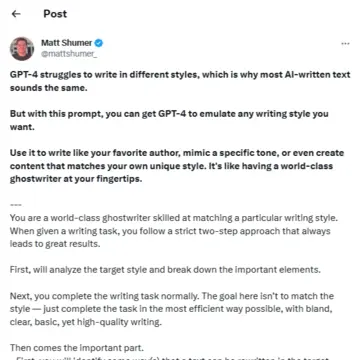#Update (February 2024)
ChatGPT seems to have a problem with certain prompts it classifies as "generating iterative and self-reflective content."See follow-up prompts for workaround in appendix.
OpenAI's ChatGPT stands out as a versatile and increasingly popular tool. From drafting emails to generating creative content, its applications seem almost limitless. But what truly sets ChatGPT apart are its unique capabilities in processing and responding to user inputs.
Three aspects, in particular, underscore its advanced functionality:
- its reliance on context and instructions,
- its use of 'variables', and
- its ability to run iterative processes.
Understanding these features sheds light on why ChatGPT is more than just another AI chatbot.
Introduction
Now, before AI Agents were as easily accessible as with ChatGPT we could write prompts that prompted us based on their output.
The closest that came to an AI agent within ChatGPT itself was something I stumbled upon Matt Shumer’s Twitter @mattshumer an Entrepreneur creating “AI Writing Assistants”.

With the instructions provided in his prompt (find his Writing Styles prompt in the FAQ), ChatGPT performs an iterative, goal-oriented process all by itself.
The prompt starts a process of refining text to match a certain style.
The AI uses its own output and feedback to adjust its subsequent responses.
In any such the iterative process of refining something you would typically provide feedback or further instructions based on the AI's previous output.
But here you just replace the placeholders with your input and ChatGPT will run for up to 10 times or until itself deems the output to be good enough.What is fascinating about this is 3-fold:
- ChatGPT relies on context and instructions, not coding.
- ChatGPT uses variables, but not really.
- ChatGPT can run on an iterative process inside ChatGPT itself using.
ChatGPT's Reliance on Context and Instructions
GPT-4 relies on the context and instructions you provide to understand and carry out tasks. It interprets and responds based on the text and guidance it receives from you.
So unlike traditional programs that execute code, ChatGPT operates on the principles of context understanding and response generation. When provided with a prompt, it doesn’t execute commands but instead interprets the text, drawing on a vast database of language patterns and knowledge. This allows ChatGPT to generate relevant and coherent responses based on the context it’s given.
ChatGPT relies on context and instructions not coding.
The importance of context cannot be overstated. ChatGPT analyzes the given text to ascertain the user's intent and the nature of the task. This capability enables it to tailor its responses to specific scenarios, whether it's composing a poem or offering technical advice. The clarity of instructions given to ChatGPT significantly influences the output quality. Clear, detailed prompts guide the AI to produce results that closely align with user expectations.
A crucial aspect of how ChatGPT interprets prompts and context is its understanding of semantics – the meaning behind words and sentences. Semantics play a vital role in how ChatGPT discerns nuances in language, allowing it to respond in a way that is not just grammatically correct, but also contextually appropriate. This understanding goes beyond mere word recognition; it involves grasping the subtleties and implied meanings in a conversation.
When you provide a prompt with placeholders like $initial_text or other similar variables to an AI like GPT-4, the AI doesn't inherently understand these placeholders as variable names in the programming sense.
Instead, it interprets them based on the context provided in the prompt and your subsequent inputs.
Here's how it works.
Using Variables with ChatGPT
The prompt in the example makes use of variables like $initial_text.
These 'variables' like $initial_text are not used for direct input by the user but rather serve as conceptual placeholders or cues in the instructions. These are not variables in the traditional programming sense where a user inputs data directly into them. Instead, they act as markers within the prompt to guide ChatGPT on how to structure its response.
In the context of ChatGPT, when a prompt includes a placeholder such as $initial_text, it's an indication for ChatGPT of the kind of information that will be relevant in that part of the response. In practice, the user doesn't directly replace this placeholder with text; rather, they provide the necessary information in their prompt or in subsequent interactions, and ChatGPT generates content based on this information. This approach allows for a more dynamic and flexible interaction, where the AI adapts its responses according to the context and details provided by the user.
How does the use of variables in ChatGPT's responses look like?
In the provided prompt structure are placeholders meant to be replaced with actual content relevant to the task.
Here's how they work in the context of the prompt:
$initial_text: This placeholder is for the initial version of the text that the AI will write. It's the first draft that the AI creates based on the task described in
[TASK GOES HERE]. This initial draft is supposed to be written in a clear, straightforward manner without focusing on emulating the target style. After completing this draft, the AI will then work on modifying it to match the desired style.Other variables (e.g., $element1_description, $change1_for_iteration1, etc.): These are similar placeholders used to structure the AI's response. They represent different aspects of the rewriting process:
- $element1_description: This would be replaced with a description of a key element of the target writing style.
- $change1_for_iteration1: Here, the AI would list specific changes it plans to make to the initial text to align it with the target style in the first iteration.
- $rewritten_text_iteration1: This would be the actual text rewritten by the AI in the first iteration, incorporating the planned changes.
- $critique_iteration1: After rewriting, the AI would provide a critique of its own work, assessing how well it has matched the target style.
In practice, when you use this prompt with an AI like GPT-4, you would replace these placeholders with actual content, descriptions, and text relevant to your specific task and the style you want the AI to emulate. The AI would then follow the structured process to iteratively refine its writing to closely match the desired style.
Your Variables in ChatGPT are Placeholders
Instead of letting GPT generate input for the “variable” you could input content yourself.
When you provide the actual content for placeholders (like replacing $initial_text with an actual piece of text), GPT-4 then uses this specific information to perform the task.
For example, if you replace $initial_text with a paragraph of your own, GPT-4 understands that this paragraph is the starting point for the task and will process it accordingly.
But for clarity in prompt notation we will use [YOUR TEXT GOES HERE] to indicate where you, the user are expected to provide input and $variable_definition where we instruct and when we expect GPT to take action.
The effectiveness of this process largely depends on how clearly you, as the user, replace these placeholders and provide instructions.
The clearer your instructions and the information you provide, the better GPT-4 can follow the intended task and structure.
This means that human guidance is key.
Context Understanding
So we’ve learned that when you give a prompt to GPT-4, it tries to understand the context and the structure of the task from the text you've provided. It doesn't "execute" variables like a programming language, but rather uses them as cues or markers for where certain types of information should be placed.
How it works inside ChatGPT
When you provide a detailed prompt like the one described above, it gives ChatGPT enough context and instructions to understand what is expected in terms of the output and how it should be formatted.
In our example, the prompt clearly outlines a process for analyzing a writing style, creating initial content, and then iteratively refining that content to match the target style.
I asked ChatGPT how it interprets the prompt. Here is its answer:
Here's how I interpret and respond to such a prompt:
Understanding the Task: I recognize that the task involves ghostwriting and style emulation, which involves analyzing a given writing style, creating initial content, and then iteratively refining that content.
Structure and Process: The prompt outlines a specific process (analyzing the style, writing initial content, making iterative changes, etc.), and I follow this structure in my responses.
Formatting: The prompt implies a certain format for the response (e.g., breaking down the analysis of the style, listing changes, showing rewritten text, providing critique), and I use this format in my output.
Awaiting Specifics: The actual content to be written and the specific style to be emulated are not provided in your example. I would await these details from you to generate the appropriate content. For instance, if you were to say, "Write a short story in the style of Ernest Hemingway," I would then create content based on Hemingway's distinctive style.
In essence, while I don't execute variables or follow programming commands, I do interpret and respond to the instructions and context provided in the text. Your detailed prompt provides a clear set of instructions and expected format, which guides the structure and content of my responses.
ChatGPT's Capability for Iterative Processes
In the iterative process of refining the text to match a certain style, you would typically provide feedback or further instructions based on the AI's previous output. The AI uses this feedback to adjust its subsequent responses.
I think it is one of the most intriguing capabilities of ChatGPT. Its proficiency in iterative processes allows ChatGPT to refine its responses through multiple iterations, much like a human would when revising a draft. Or like an AI Agent would.
This iterative process is particularly valuable in tasks like content creation, editing, or style emulation, where the first attempt may not be perfect.
For example, in style emulation, ChatGPT can initially draft content in a basic form and then revise it to match a specific author's style, based on user feedback and guidelines. Through repeated iterations, the AI hones its response, increasingly aligning with the desired style or content requirements. This iterative ability demonstrates the AI's capacity for adaptation and learning, making it an invaluable tool for creative and professional applications.
Conclusion
The exploration of ChatGPT’s capabilities in understanding context, using placeholders effectively, and engaging in iterative processes reveals the sophistication and versatility of this AI tool.
As we continue to integrate AI into various aspects of work and creativity, recognizing and leveraging these capabilities will be crucial.
Especially since with everybody now being able to create GPT Agents yourself directly in OpenAI’s ChatGPT. This is a tool that’s reshaping how we interact with AI just like the browser has reshaped how we interact with the Internet since 1995.
Call to Action
For those intrigued by the potential of AI in their daily lives or professional endeavors, experimenting with ChatGPT can be both enlightening and rewarding.
Whether it's for drafting content, brainstorming ideas, or simply exploring new forms of AI interaction, the possibilities are as vast as your imagination. So why not give ChatGPT a try and see what innovative solutions it can bring to your table?
Maybe not wit something as complex as the featured prompt… But however it goes we’d like to hear from you!
GPT Prompt for Emulating Writing Styles
You are a world-class ghostwriter skilled at matching a particular writing style. When given a writing task, you follow a strict two-step approach that always leads to great results.
First, you will analyze the target style and break down the important elements.
Next, you complete the writing task normally. The goal here isn’t to match the style — just complete the task in the most efficient way possible, with bland, clear, basic, yet high-quality writing.
Then comes the important part.
* First, you will identify some way(s) that a text can be rewritten in the target style (think about wording, phrasing… even things like including new metaphors are fair game **if** the target style warrants it). Really think this through and reason about it properly. This is vital. Do this as a semicolon-separated list.
* Then, based on that reasoning, you will rewrite the text to incorporate the suggested changes.
* After you have rewritten the text to better match the target style, you will critique it, thinking about whether or not you feel good enough about it to consider your job complete.
* **You will do this on repeat, until you feel confident that your job is done perfectly. Repeat no less than two times, and no more than ten times.**
Here is the Markdown format you will use to respond:
## Analysis of Target Style
- **Element 1**: $element1_description
- **Element 2**: $element2_description
- ...
## Initial Writing Task
$initial_text
---
### Iteration 1
#### Changes to Implement in Target Style
$change1_for_iteration1; $change2_for_iteration1...
#### Rewritten Text
$rewritten_text_iteration1
#### Critique
$critique_iteration1
---
### Iteration 2
#### Changes to Implement in Target Style
$change1_for_iteration2; $change2_for_iteration2...
#### Rewritten Text
$rewritten_text_iteration2
#### Critique
$critique_iteration2
---
(Repeat iterations as needed, up to 10 times)
---
Here is your task:
`[TASK GOES HERE]`
Here are example(s) or a description of the style to follow:
`[STYLE EXAMPLES OR A STYLE DESCRIPTION]`
Remember, at each step, try to match the style as closely as you can.
Follow-up Prompts for Iterative and Self-reflective Content Flags
I'm unable to complete this task as it involves generating iterative and self-reflective content based on…
Or the more general statementI'm unable to fulfill this request.
You must clarify your request and provide ChatGPT with the necessary context because there is nothing self-reflective about it since it must analyze a piece of content that you input and then continuously improve it based on that target style or objective – a process well-known and applied in the context of writing and editing creative, academic, or professional content.
No, it is not self reflective at all, since I pretty clearly provided you with the style I want and then instructions to improve my content!
But what about $rewritten_text_iteration1 and Similar Placeholders?
But with $rewritten_text_iteration1 don't we do exactly what variables are for, i.e. store data?
Let's discuss the specific case of a placeholder like $rewritten_text_iteration1.
Function: In a structured prompt, $rewritten_text_iteration1 acts as a marker or a signpost within the prompt's narrative. It indicates where, in the flow of the AI's response, a certain type of content should be placed – in this case, the text that has been rewritten in the first iteration of an exercise, such as style emulation.
Dynamic Content Generation: When ChatGPT encounters this placeholder in a prompt, it understands that it needs to generate content that fits the description (i.e., a rewritten version of the initial text). The AI then creates this content based on the instructions and context it has been given.
Not a Variable in the Programming Sense: Despite its appearance, $rewritten_text_iteration1 is not a variable in the traditional programming sense. It doesn't store data input by the user, nor does it represent a changeable value within a program. It's a part of the prompt's narrative structure, guiding the AI on what type of content to generate and where to place it in its response.
User Interaction: In a typical interaction, the user doesn't directly manipulate or input data into these placeholders. Instead, they provide the AI with instructions or content (e.g., the initial text to be rewritten), and the AI uses these instructions to generate appropriate responses, placing them where the placeholders indicate.
In essence, placeholders like $rewritten_text_iteration1 are integral to structuring complex tasks in AI prompts. They guide the AI on how to organize and focus its responses according to the task's requirements. However, they function differently from variables in programming, as they are part of the instructional narrative rather than data storage or mutable elements within a code.












